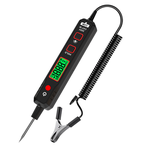Choice between Handheld Infrared Thermometer and Portable Hardness Tester
Handheld infrared thermometers can be divided into several aspects:
In terms of performance indicators, such as temperature range, spot size, operating wavelength, measurement accuracy, response time, etc; In terms of environment and working conditions, such as ambient temperature, windows, display and output, protective accessories, etc; Other factors such as ease of use, maintenance and calibration performance, and price also have a certain impact on the choice of thermometer. With the continuous development of technology, the optimal design and new progress of infrared thermometers provide users with various functions and multi-purpose instruments, expanding their choices.
1. Determine the temperature measurement range
The temperature measurement range is the most important performance indicator of a thermometer. The coverage range of products such as INFR (Infrared Era) and Raytek is -50 ℃ -+3000 ℃, but this cannot be achieved by one type of infrared thermometer. Each model of thermometer has its own specific temperature measurement range. Therefore, the user's measured temperature range must be considered accurately and comprehensively, neither too narrow nor too wide. According to the blackbody radiation law, the change in radiation energy caused by temperature in the short band of the spectrum will exceed the change in radiation energy caused by emissivity error. Therefore, short waves should be used as much as possible for temperature measurement. Generally speaking, the narrower the temperature measurement range, the higher the resolution of the output signal for monitoring temperature, and the easier it is to solve the problem of accuracy and reliability. If the temperature measurement range is too wide, it will reduce the temperature measurement accuracy. For example, if the measured target temperature is 1000 ℃, first determine whether it is online or portable, and if it is portable. There are many models that meet this temperature requirement, such as Ti315, Ti213, etc.
2. Determine the target size
Infrared thermometers can be divided into monochrome thermometers and two-color thermometers (radiation colorimetric thermometers) based on their principles. For monochrome thermometers, the area of the measured target should fill the thermometer's field of view during temperature measurement. It is recommended that the size of the target being tested exceed 50% of the field of view size. If the target size is smaller than the field of view, the background radiation energy will enter the visual and acoustic symbols of the thermometer and interfere with the temperature reading, causing errors. On the contrary, if the target is larger than the field of view of the thermometer, the thermometer will not be affected by the background outside the measurement area. For a dual color thermometer, its temperature is determined by the ratio of the radiated energy within two independent wavelength bands. Therefore, when the target being measured is small and not filled with the field, and there is smoke, dust, or obstruction on the measurement path that attenuates the radiation energy, it will not affect the measurement results. Even in the case of energy attenuation of 95%, the required temperature measurement accuracy can still be guaranteed. For targets that are small and in motion or vibration; Sometimes targets that move within the field of view or may partially move out of the field of view, under these conditions, using a dual color thermometer is the best choice. If it is impossible to directly aim between the thermometer and the target, and the measurement channel is bent, narrow, or obstructed, a dual color fiber optic thermometer is the best choice. This is due to its small diameter, flexibility, and the ability to transmit optical radiation energy through curved, obstructed, and folded channels, making it possible to measure targets that are difficult to approach, have harsh conditions, or are close to electromagnetic fields. Selection of Handheld Infrared Thermometers and Portable Hardness Testers






